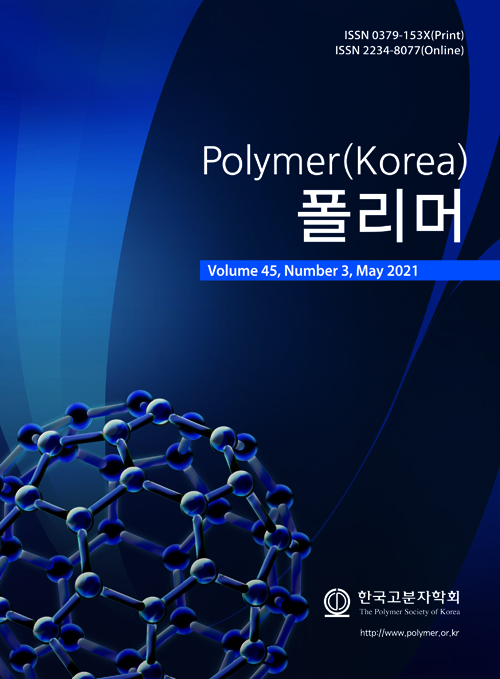- Tooth Whitening and Protecting Effect Using TiO2/PLCL Biodegradable Polymer Composites
Department of Chemical Engineering, College of Engineering, Dankook University, Jukjeon-dong, Yongin-si, Gyeonggi-do 16890, Korea
- TiO2/PLCL 생분해성 고분자 복합체를 이용한 치아 미백 및 보호효과에 대한 연구
단국대학교 화학공학과
Reproduction, stored in a retrieval system, or transmitted in any form of any part of this publication is permitted only by written permission from the Polymer Society of Korea.
Poly(L-lactide-co-ɛ-caprolactone) (PLCL) was synthesized, and this was mixed with TiO2 for tooth manicure. A mechanical test was conducted using a tensile strength testing machine and pencil hardness tester; these tests indicated that the optimal molar ratio of lactide in PLCL was 50%. Differences in the surface structures of the films with respect to the hydrophobicity and the whitening effect were examined using a digital microscope, a contact angle meter, and colorimeter. The optimal ratio of TiO2 for the composite was determined to be 10%. The composite coated glass plate yielded a good cell adhesion rate in fibroblasts. The TiO2/PLCL composite manufactured by this simple method can be applied to implantable dental materials, used for tooth whitening, and as a protecting agent during tooth manicures
치아매니큐어에 적용하기 위한 베이스 레진으로 poly(L-lactide-co-e-caprolactone)(PLCL)을 합성하였고, 락티드와 카프로락톤의 최적 비율을 결정하였다. TiO2는 미백을 위한 안료로 적용되어졌으며, 최적의 TiO2/PLCL 조성비를 위해 탄성회복률, 연필심 경도 측정, 색차계 시험, 접촉각 측정을 진행하였다. 이를 통해 PLCL을 위한 락티드와 카프로락톤의 최적비율은 50:50이였으며, TiO2의 최적 비율은 10%임을 확인하였다. 세포독성 시험 결과 우수한 세포 부착 및 증식 효과를 확인하였고, 천연 치자색소를 이용하여 다양한 노란색 코팅제를 제조해 보았다. 본 연구결과 TiO2/PLCL 복합체는 치아 미백 및 미용 매니큐어의 재료로 적합한 것으로 판단된다
Keywords: tooth manicure, whitening, protecting, poly(L-lactide-co-e-caprolactone), titanium dioxide
- Polymer(Korea) 폴리머
- Frequency : Bimonthly(odd)
ISSN 0379-153X(Print)
ISSN 2234-8077(Online)
Abbr. Polym. Korea - 2023 Impact Factor : 0.4
- Indexed in SCIE
 This Article
This Article
-
2021; 45(3): 421-427
Published online May 25, 2021
- 10.7317/pk.2021.45.3.421
- Received on Dec 10, 2020
- Revised on Jan 30, 2021
- Accepted on Feb 8, 2021
 Correspondence to
Correspondence to
- Jin Ik Lim
-
Department of Chemical Engineering, College of Engineering, Dankook University, Jukjeon-dong, Yongin-si, Gyeonggi-do 16890, Korea
- E-mail: limjinik@dankook.ac.kr









 Copyright(c) The Polymer Society of Korea. All right reserved.
Copyright(c) The Polymer Society of Korea. All right reserved.